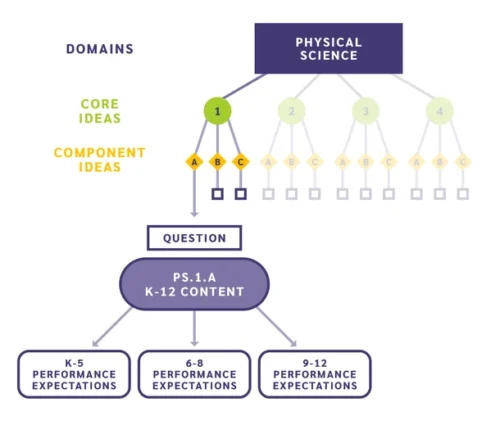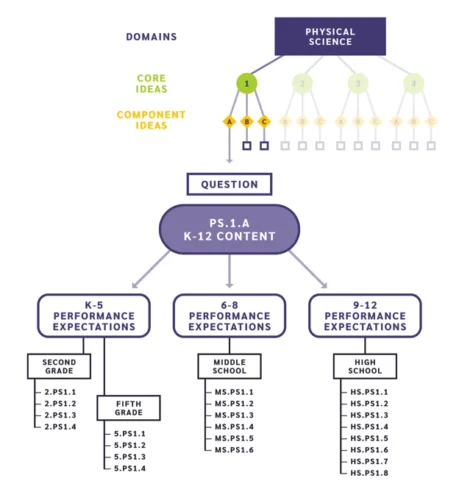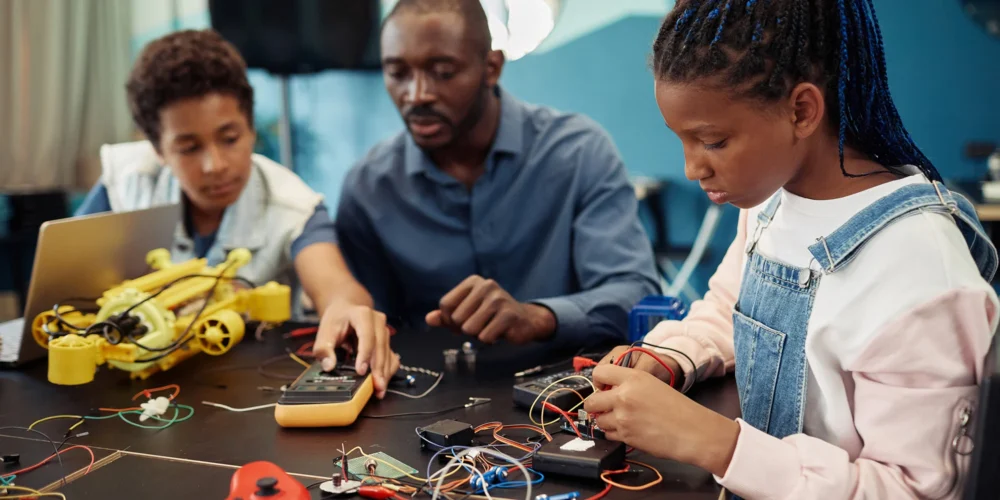When science teachers embrace grade-level, engaging, affirming, and meaningful (GLEAM™) science instruction, students follow their curiosity, test hypotheses, and deepen their understanding over time — just as scientists have for thousands of years. UnboundEd is dedicated to supporting educators as they facilitate and inspire students through this process, and we’ve given some examples of what this looks like in previous posts. Now, the question we’ll begin to tackle is: How do we get there?
Imagine a second-grade teacher reading a science lesson plan and seeing this standard:
2-PS1-2. Analyze data obtained from testing different materials to determine which materials have the properties that are best suited for an intended purpose.
She wonders: How should this inform my planning and instruction?
One major challenge she faces is interpreting the organization of science standards. While this might seem a bit technical, it’s essential for bringing the first element of GLEAM™ instruction (grade-level) to life by building teachers’ capacity to understand their particular role as part of the whole body of science content. In this post, we walk through the structure of the Next Generation Science Standards (NGSS) structure, or similar sets of state standards, from their origins in A Framework for K-12 Science Education (often referred to as “the Framework”). We’ll also share some reflection questions that can help establish the practice of understanding how the daily lessons fit into the K-12 science scope.
We answer two questions:
- How do the codes reveal the coherence of the standards?
- How can knowing the standards improve our teaching and student learning?
How do the codes reveal the coherence of the standards?
Our teacher wants to put her Performance Expectation in context with its role in the K-12 content body. The beauty and complexity of the standards’ comprehensive design become evident when we decipher the codes for the Disciplinary Core Ideas and see their relationship to the codes of the Performance Expectations.
The Framework organizes K-12 science content into four “domains”: Physical Science (PS), Life Science (LS), Earth Science (ES), and Engineering, Technology, and Applications of Science (ETS). It then breaks down each domain into “core ideas” (designated by a number), which are then further parsed out into “component ideas” presented as a question (designated by a capital letter). What follows is all the science needed to explain this aspect of the world bucketed into grade bands. For example, see the image below to visualize the origins of the Disciplinary Core Idea PS.1.A (Domain-Physical Science, Core Idea 1, Component Idea A).

Domains and Core Ideas (From the Framework)
Physical Science (PS)
- PS1: Matter and Its Interactions
- PS2: Motion and Stability: Forces and Interactions
- PS3: Energy
- PS4: Waves and Their Applications in Technologies for Information Transfer
Life Science (LS)
- LS1: From Molecules to Organisms: Structures and Processes
- LS2: Ecosystems: Interactions, Energy, and Dynamics
- LS3: Heredity: Inheritance and Variation of Traits
- LS4: Biological Evolution: Unity and Diversity
Earth and Space Science (ESS)
- ESS1: Earth’s Place in the Universe
- ESS2: Earth’s Systems
- ESS3: Earth and Human Activity
Engineering, Technology, and Applications of Science (ETS)
- ETS1: Engineering Design
- ETS2: Links Among Engineering, Technology, Science, and Society
Starting with these Disciplinary Core Ideas, the writers of NGSS integrated Science and Engineering Practices and Crosscutting concepts and created three-dimensional Performance Expectations in a numbered list, addressing the questions from the component ideas in order. The Performance Expectations were then assigned to specific grade levels (K-5) or grade bands (6-12). Thus, they established what students should know and do by the end of each grade or grade band coherently, helping teachers better identify their role in the progression of a student’s scientific literacy. For example, see the image below to visualize the origins of our teacher’s Performance Expectation, 2-PS1-2 (Grade 2, Physical Science, Core Idea 1, PE 2).

How can familiarity with the standards improve teaching and learning?
Let’s go back to our second-grade teacher. Once she connects her grade-level specific standard to the overall architecture and design of the standards, she’s equipped to see what her students need to learn in this lesson to work towards explaining broader science ideas.
She can contextualize her individual Performance Expectations with a few guiding questions:
- What is the question the Core Idea asks students to explain throughout their K-12 experience?
- What must they learn in my grade-level or class to meet this progression for each dimension?
- What other Performance Expectations build knowledge around this Core Idea?
In reflecting on these questions, our teacher can look for how she will provide opportunities to build students’ capacity to consider what type of material they are looking for based on the situation, then test different materials, collect data, and analyze the results. She knows that in the long term, her students are working towards explaining how particles combine to form the variety of matter one observes (PS1); her part in this lesson is to allow students to learn to observe this variety. In addition, other Performance Expectations will build students’ capacity to work towards furthering this by using observable properties to classify materials (2-PS1-1) and learn how the same pieces of matter can create different combinations (2-PS1-3).
If she looks ahead, she’ll see that in the fifth-grade Performance Expectations (5-PS1), students build on this and develop models to represent matter too small to be seen, explore conservation of mass, use properties to identify materials, and begin mixing materials to understand how new substances are created. When they finish middle school, students are expected to understand the general ideas about the atomic model and concepts related to how matter changes. By high school graduation, students can deeply explain chemical reactions.
By asking these questions, our teacher ensures what her students learn is at grade-level and facilitates identity development as scientists within the trajectory of their future learning. UnboundEd is committed to ensuring this is a reality for all students by equipping educators with the tools needed to spend more time reaching students and less time getting lost in the codes of the standards!
Ready to bring GLEAM™ science instruction to life?
Are you a science educator or school leader looking to increase student engagement and success with science? Check out the science learning opportunities at Standards Institute™ or Summit, and please share this blog with other science educators in your orbit!
Resources
- NGSS Lead States. (2013). Next Generation Science Standards: For States, By States. Washington, D.C.: The National Academies Press. https://www.nextgenscience.org/
- National Research Council. (2012). A Framework for K-12 Science Education: Practices, Crosscutting Concepts, and Core Ideas. Washington, D.C.: The National Academies Press. https://doi.org/10.17226/13165.
